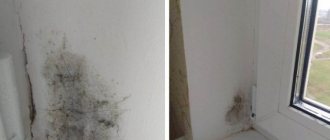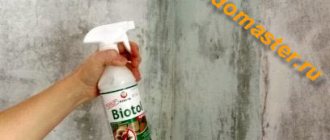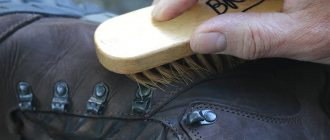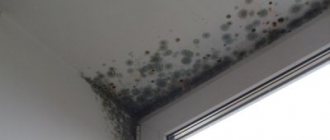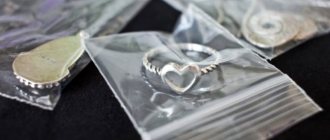- What is mold and what causes it?
- "Habitats" of fungus in a washing machine
- Cleaning the washing machine from mold using household chemicals
- How to clean mold from a washing machine using folk remedies
- How to get rid of fungus in a washing machine: secrets of removing mold from various elements
- “It’s easier to prevent than to treat”: preventing the appearance of fungus
- Finally
Ways to get rid of mold in a washing machine
If the case is not advanced, you can relatively quickly and easily remove mold from the surfaces of the machine with your own hands and using a rag. But most often we see a problem because it is too big. If mold has developed in hidden cavities of the tank and hard-to-reach units, you need to take the matter seriously and thoroughly.
Heat and acid
Mold does not tolerate high temperatures and acids. A dry environment is also uncomfortable for her.
- Turn on the washing machine for a long wash at 95 degrees (without putting laundry in it). Pour about a liter of chlorine bleach, such as Blezna, into the dispenser tray.
- When the temperature reaches its maximum, pause the wash cycle for a few hours.
- Turn on the machine again and wait until the wash is completed.
- Pour 3 cups of 11% table vinegar into the dispenser tray. Turn on the machine in rinse mode.
- After the process is completed, open the machine and dry it thoroughly. You can even wipe with a dry towel to speed up drying.
Some housewives prefer to use vinegar and bleach at the same time. But this method is too radical and can harm machine parts.
Baking soda, citric acid and laundry detergent with bleach will help you deal with mold.
sunlight
If possible, take the washing machine outside in sunny, hot weather. Ultraviolet light is harmful to black mold. Leave the machine with the lid open in the sun for one day and the fungal colonies will be destroyed.
Copper sulfate
Rub the inside of the rubber cuff with a 50% solution of copper sulfate. Leave for a day, then wash with water and powder or detergent. If you do this after every wash, mold will no longer appear.
Lemon acid
A solution of citric acid will help not only remove mold, but also eliminate unpleasant odors. Dilute citric acid (400 g) in a liter of water, pour the solution into the powder tray and turn on the machine for the maximum washing time. Select the “boiling” mode without adding laundry.
Ventilation
Often mold forms inside the cuff because the machine is poorly ventilated. Therefore, after each wash, be sure to leave the door open to prevent moisture from getting a chance.
Use of special equipment
If none of the above methods help, then you will have to disassemble the machine and thoroughly wash all internal surfaces. To do this, you can use soda, Domestos or special products that destroy fungus. After this, keep the cleaned parts in the sun or under an ultraviolet lamp.
Symptoms of poisoning
When consuming products on which mold has formed due to violation of storage standards, symptoms characteristic of food poisoning appear:
- nausea;
- vomit;
- bowel disorders;
- headache;
- severe weakness, dizziness;
- temperature increase.
The described symptoms are short-term, usually of moderate intensity. With adequate therapy, the patient's condition returns to normal within 2-3 days.
When living in premises contaminated with black or white mold, there is a high risk of poisoning not only in people (especially children), but even in pets.
The toxin of this mold is very active, getting into the respiratory tract can negatively affect the respiratory system, causing exacerbation of chronic bronchitis, sinusitis, and provoke the development of bronchial asthma. Typical complaints in this case:
- cough;
- sore throat;
- nasal congestion;
- lacrimation;
- chest pain;
- headache;
- the appearance of wheezing, shortness of breath;
- increased fatigue.
What to do if mold appears on the rubber band of your washing machine
The main reason why your washing machine smells musty is because there is fungus in it. It must be dealt with, since a person may experience various allergic reactions. As a result, the immune system is weakened, and many other infections can attack the body.
In order to remove mold from the rubber band of a washing machine as much as possible, you need to understand what it is most afraid of. It is necessary to act in several ways at once, then the result will be. The fungus disappears if it is exposed to acids and high temperatures. Also, all parts of the washing machine must be dry.
In this case, you need to do the following:
- pour “Belizna” into the powder dispenser;
- start the long-term wash mode at maximum temperature;
- After an hour of washing, you need to stop the program and let the machine stand for about an hour. After this, continue washing;
- after the main program ends, pour a few tablespoons of vinegar into the measuring tank, and then turn on the “Rinse” mode;
- after rinsing, you must thoroughly wipe all the internal parts of the machine;
- also wipe the measuring tanks dry;
- The washing machine should be left open for several days to allow the unpleasant odor to dissipate.
Reasons for appearance
Is mold dangerous or a good neighbor? Research shows that its appearance in an apartment can significantly affect human health.
Normal indoor humidity levels should generally not exceed 80%. If indicators are rising, this is influenced by a number of reasons:
- an abundance of indoor plants;
- lack of proper ventilation in the apartment;
- wet bed linen is dried in the bathroom;
- high indoor temperatures in cold weather outside contribute to the formation of condensation;
- The apartment is heated unevenly.
Household fungus in an apartment occurs primarily in places where moisture accumulates: the bathroom, on the ceilings, behind cabinets, under window sills, etc. If you have already noticed the presence of such a threat in your home, it is worth taking comprehensive measures to eliminate mold before living in the apartment becomes too dangerous.
How to clean the tray in the machine
If the car smells damp, but the fungus is not visible externally, this is not a reason to think that it is not there. Colonies can hide under a rubber rim or in other secret places (in a hose, drain). You can get rid of smell and mold in an automatic washing machine at home using different methods.
This is a more concentrated acid, so you will need less of it: half a glass. The washing is started in the same mode. Only the vinegar is not poured in immediately, but after the machine has drained the first portion of water.
Other remedies that can eliminate the immediate problem are baking soda, dishwasher tablets, and chlorine bleach.
For treatment, mix several tablespoons of soda with water to obtain a paste-like mass, which is used to treat fungal lesions with a brush. The baking soda should work for about half an hour. After this, they also start the wash “idle”, setting the maximum time and temperature. For greater effectiveness, you can pour a couple of spoons of powder into the tray.
Cleaning with dishwasher tablets
The peculiarity of this method is that the tablets (6 pieces) are placed not in a powder reservoir, but directly in a drum. Next, start the wash as described above. Approximately in the middle of the cycle, you need to pause the program (or turn off the machine if it does not have such a function) and wait for at least 3 hours. During this time, boiling water and the active ingredients of the tablet should remove odor and mold. After this, the washing is completed.
Cleaning with chlorine-containing products
This method of eliminating odor and fungus is good for very advanced cases, but is not suitable for all cars. The instructions must indicate that the use of chlorine is acceptable.
The principle is the same: long wash at high temperature without laundry. Pour a liter of chlorine bleach into the powder reservoir and start the wash. Likewise, in the middle of the process, the machine is stopped for at least an hour and a half, after which it is started again.
At the end of the cycle, pour 2 cups of 9% vinegar into the tank and start the rinse mode.
When cleaning at home, pay attention to the sounds your washing machine makes. If large pieces of plaque and scale get into the drain, they must be removed immediately, otherwise your assistant may be damaged. Unusual noise, whistling, grinding, buzzing is a reason to immediately press pause and check for the presence of pieces of deposits in the drum and drain.
Cleaning the powder receiver compartment was not easy, as there were a lot of hard-to-reach places, small protruding parts and grooves covered with rust. We deliberately did not bring the result to the ideal; it was too labor-intensive work.
You can do something more cunning: generously spray all the walls of the compartment with a cleaning agent from a spray bottle, leave the plaque to soak for a couple of hours, and only then start cleaning by hand.
Next, we proceed to cleaning the tray itself, which is usually covered with a rusty coating, remnants of powder and other cleaning additives. For this you can use:
- A mixture of vinegar and soda;
- Pemolux and other household chemicals;
- A mixture of hot water, vinegar and soda.
Cover the container with your chosen product and leave/soak it for 30 minutes, or preferably a couple of hours.
If you have a dishwasher, you can wash the tray in it. The rust may not completely disappear, but cleaning it in the dishwasher will make it much easier to remove.
Well, that's all, the inside of the car is clean and ready for work! All you have to do is restore its external beauty: wipe the control panel (especially the protruding buttons), wash the door inside and out, wipe the top and side panels.
Drum
You can clean the drum using any of the methods described earlier. An excellent result is guaranteed by the use of ready-made products, for example, Frisch Active. All such products require following a certain algorithm:
- the product is poured into a measuring cap;
- half of the liquid is poured into the powder tray, and the second into the drum itself;
- start washing at a temperature of 70 degrees without laundry, avoiding draining the water;
- at the end of the cycle, leave the solution in the machine for at least 30 minutes, then start draining;
- turn on the rinse mode, then drain the water again.
The latest models of machines have a special program that allows you to clean the drum from grease, mold and scale. In this case, the procedure is reduced to pressing a few buttons.
How to Prevent Mold Formation
To ensure that future use of the washing machine does not lead to the appearance of fungus, you need to use it correctly. For prevention, every month add citric acid to the powder compartment and run a long wash cycle without putting laundry in the drum. This procedure will get rid of mold and scale and protect against bacteria.
Often, fungus spreads in the washing machine due to rinse aids. Moreover, the higher the cost of the product, the better mold spreads in its remains. Therefore, after each use of the conditioner, remove the tray and rinse it well, and wipe the inside of the drum with a cloth.
Do not store dirty laundry in the washing machine; the appliance is not designed for this. In addition, sweat, epithelial particles and fat are an excellent environment for the spread of mold and the appearance of an unpleasant odor. Therefore, dirty clothes must be placed in a special basket.
Drain hose
In case of blockage and to prevent stagnation, you should periodically rinse the flush hose. Need to:
- Use chemicals. It is better to purchase a specialized product at any hardware store. The product is poured into the tray and washed without clothes.
- Carry out dismantling. The hose is removed and then cleaned by hand. Then they are installed in place.
Where does mold appear?
The growth of fungus on rubber components of automatic machines is usually caused by the following factors:
- Humidity. The household appliance is mainly installed in the bathroom. Regular high air humidity is the main cause of mold. To minimize the development of fungus from inside the drum, you should always open the machine door for ventilation after washing.
- Warm. Black plaque forms faster in warm rooms. In addition, its appearance is stimulated by warm water used for washing.
- Dirt. Bacteria and spores constantly get into the drum of the machine from things. This is a favorable environment for mold development and odor.
If the drum begins to smell unpleasant, and black spots appear in some places, you need to take immediate action. However, before destroying the fungus, it must be found. Sometimes this task causes some difficulties. Mold mainly develops in:
- filter;
- compartment for powder and conditioner;
- on elastic bands inside the drum;
- on the inlet and drain hoses.
The appearance of black mold inside a household appliance should not be ignored. These microspores lead to the development of local and general allergic reactions. In particular, they cause itching, redness of the skin, and peeling. In severe cases, mold can cause Quincke's edema or severe urticaria. In addition, the fungus negatively affects the respiratory system. Regular penetration of spores into the respiratory tract leads to bronchitis, pneumonia, exacerbation or development of bronchial asthma.
The largest amount of fungus accumulates between the rubber bands that separate the porthole from the drum. Small debris often remains here, and the water takes a long time to evaporate. You can clean your washing machine from mold and dirt using folk recipes or using household chemicals.
Facilities
Table 1. How to remove mold from a washing machine.
| Name of the product | More details |
| Folk recipes | |
| Lemon acid | It is recommended to mix citric acid with washing powder in a ratio of 1:2. Dilute the resulting mixture with water to a paste-like state and apply to the affected areas. After 24 hours, rinse off the product with warm water. |
| Copper sulfate | Moisten a soft cloth generously with the liquid. Wipe the elements of the device with a cloth, then wash off with warm water and soap. |
| Household chemicals | |
| White | A quick way to get rid of fungus is to apply Whitening. Mold is “afraid” of chlorine in any form and lags behind literally before our eyes. For safety reasons, it is better to use gloves and a mask. |
Wipe the rubber seal thoroughly. This especially applies to the inside of the component. It needs to be cleaned with a soft cloth wrapped around your finger. Wash the machine door. You can use any detergent: soap, dishwashing gel, glass cleaner. Do the washing
To ensure mold removal, it is important to be sure to run the wash cycle at maximum temperature without pre-loading the laundry. For best results, you can add a little bleach to the water.
What is this smell?
Yes, yes, the smell of dampness and swamp, black spots on rubber seals - this is the most common mold, and in some cases it is not so easy to get rid of it. Scientists are already vying with each other to say that our household helpers - washing machines and dishwashers, without which the life of a modern family is unthinkable - are dangerous sources of allergens.
The successful treatment program for any allergy, regardless of its cause, includes three main components: taking antiallergic drugs, taking enterosorbents and stopping contact with the allergen. Antiallergic drugs are prescribed by the doctor depending on the manifestations of the disease and the characteristics of the patient’s body.
Among the wide range of enterosorbents, it is worth choosing the safest and most effective. Thus, Enterosgel thoroughly removes toxins and allergens from the body without affecting the beneficial intestinal microflora. The gel is very gentle and therefore suitable for use even by small children.
In order to eliminate contact with an allergen, you must first understand where it is located, what causes it, and how it can be eliminated.
Prevention of relapse
Mold is a rather annoying and stubborn fungus. Once you delete it, you cannot be sure that it will not appear again. As soon as conditions are favorable, mold will settle in the washer again
To prevent this, it is important to constantly maintain an uncomfortable environment for her:
after each wash, be sure to wipe dry all accessible cavities: tray, drum, seal, elastic band, hatch; contrary to the annoying advertising video, it is important to leave the washing machine window slightly open between washes, but the tray must be removed, rinsed and left to dry; in the room where the machine is located, there must be a ventilation system, otherwise a problem may arise due to dampness not in the machine itself, but around it; after the end of the washing cycle, the laundry must be removed immediately, without allowing it to keep the drum wet; Do not store dirty things in the drum - there are special baskets or bins for this. Otherwise, a musty smell will appear in the machine (even if the laundry is dry, there are always microorganisms on it, and particles of dried food, dead skin cells, ingrained sweat or other secretions are an excellent environment for their reproduction); when using conditioner, it is better to pour in less of it than more, and be sure to run an additional rinse to wash away any remaining product; the rinse aid and powder must be of high quality; you cannot skimp on them for the benefit of fungal development; once a month it is necessary to treat the cavities of the machine with the hottest possible water using a “idle” wash at the maximum time and temperature - such prevention will allow you to regularly get rid of microorganisms and fungi, preventing them from multiplying; every six months it is advisable to “run” the washing machine without washing clothes with citric acid; the hose and filter also require cleaning at least once every six months
It is always easier to prevent any problem than to then look for ways to resolve it. Odor and mold in an automatic car is no exception. If you do not take preventive measures, in a favorable environment the fungus and the accompanying “aroma” will certainly appear, even if they were not there before. Well, if you have, you need to take extra care of your car.
- Use only as much powder, bleach and conditioner as you actually need (see product manufacturer's instructions). After all, excess detergents do not enhance the result, but simply settle and accumulate inside the washing machine.
- Always remove small items from pockets to prevent them from clogging the drain filter.
- Try not to delay starting the machine if you have already thrown dirty things into the drum. Well, take out clean clothes immediately after washing and send them to dry.
- Try to always keep the car open to prevent mold from growing in it due to high humidity.
Why do you need to clean?
The rubber seal has a complex design with bends and folds. Dirt, hair, lint and debris accumulate in large quantities in the folds of the cuff - everything that was not removed through the filter and drain hose.
Due to the configuration, the rubber constantly maintains high humidity , which serves as an excellent environment for mold.
Attention! The remains of garbage are subject to rotting and mold infection, unpleasant odors and black spots appear - colonies of fungi and bacteria.
The musty smell not only creates an unfavorable atmosphere in the room, but also permeates washed clothes. Therefore, a responsible housewife should not have any questions about why the rubber band needs to be cleaned.
How to clean an elastic band in a washing machine from mold and odor
The largest amount of fungus accumulates between the rubber bands that separate the porthole from the drum. Small debris often remains here, and the water takes a long time to evaporate. You can clean your washing machine from mold and dirt using folk recipes or using household chemicals.
Facilities
Cleaning the machine should be done regularly. Only in this case can the washed clothes really be considered clean.
| Name of the product | More details |
| Folk recipes | |
| Lemon acid | It is recommended to mix citric acid with washing powder in a ratio of 1:2. Dilute the resulting mixture with water to a paste-like state and apply to the affected areas. After 24 hours, rinse off the product with warm water. |
| Copper sulfate | Moisten a soft cloth generously with the liquid. Wipe the elements of the device with a cloth, then wash off with warm water and soap. |
| Household chemicals | |
| White | A quick way to get rid of fungus is to apply Whitening. Mold is “afraid” of chlorine in any form and lags behind literally before our eyes. For safety reasons, it is better to use gloves and a mask. |
Wipe the rubber seal thoroughly. This especially applies to the inside of the component. It needs to be cleaned with a soft cloth wrapped around your finger. Wash the machine door. You can use any detergent: soap, dishwashing gel, glass cleaner. Do the washing
To ensure mold removal, it is important to be sure to run the wash cycle at maximum temperature without pre-loading the laundry. For best results, you can add a little bleach to the water.
A musty smell may be due to the accumulation of fungus, powder, gel and conditioner residues in the washing machine tray. This phenomenon can be avoided by periodically soaking the element in warm water with the addition of chlorine. If blackheads have already appeared, then there are several ways to solve the problem.
Surely in your home “arsenal” you already have a couple of substances that can combat mold. How to get rid of mold in a washing machine:
- Using vinegar. This liquid copes well with spores. Vinegar should be poured directly into the powder compartment, and then run a full wash cycle. If the fungus is mild, then lightly wipe the surface of the tray.
- Hydrogen peroxide and baking soda. Using this combination will not only clean the tray of accumulated dirt, but will also whiten the plastic. This is an easy way to bring newness back to your home appliance. To carry out the procedure, grind 10 peroxide tablets and mix the powder with 200 g. baking soda. Pour the resulting composition into the powder compartment and carry out a long wash without items at maximum temperature with rinsing.
Instructions
There are ways to locally remove mold. For this:
- the tray must be removed and washed under running water;
- Apply citric acid, vinegar or chlorine to the plastic;
- Gently rub the substance in with a soft brush;
- thoroughly rinse the composition from the tray;
- Wipe the component dry and install it in place.
Cleaning the drum, powder tray and rubber bands is quite simple. It is much more difficult to deal with contaminants on the internal elements of the device.
Table 2. Methods for cleaning heating elements.
| Way | Information |
| Chemical means | You can remove scale and dirt by washing at high temperatures with the addition of vinegar, citric acid or special anti-scale agents. |
| Physical cleaning | Involves removing the heating element. It is better not to carry out the procedure yourself. After removal, clean the heating element by hand under running water. It is strictly forbidden to use sharp blades or sandpaper. |
| Residual cleaning | After manual processing, the removed heating element can be cleaned until shiny with lemon juice. The element is placed in a container with lemon juice, fruit slices or diluted citric acid and left for 10-12 hours until the scale has completely descaled. |
Drain filter
You can remove dirt and debris from the drain filter as follows:
- Unscrew the filter. Before doing this, place a container nearby to drain the accumulated liquid.
- Perform cleaning. The machine is tilted over the container until the accumulated moisture is completely removed. Remove debris from the filter by hand, and wash the filter itself under running water.
- Reinstall the filter. To consolidate the result, it is better to conduct a test drain by setting the appropriate mode on the display of the household appliance.
Factory chemistry
Russian and foreign companies produce a huge number of products for cleaning mold from automatic washing machines. Various multi-component powders and gels are designed to directly dissolve mold in 1-2 applications and wash its remains from the tank, drum, pipes and hoses of the automatic washing machine. What means are we talking about?
- Kaneyo. This Japanese liquid product is equally good at ridding your washing machine of soap scum, mold, limescale and other dirt. Sold in 550 ml bottles. This amount of product is enough to clean the insides of a washing machine with a drum capacity of up to 9 kg. Price for 550 ml – 6.3 dollars.
- Nagara. Cleaning tablets from Japan that make it easy to clean your washing machine from mold and any other contaminants. The tablets are very effective and are relatively inexpensive - for 5 tablets you will pay 2 dollars.
- HG is a powdered product for automatically cleaning a washing machine from mold from Holland. Suitable for all types of machines. One pack of 0.162 l goes to a washing machine with a load of up to 7 kg. If your washing machine has a load of more than 7 kg, take two packs. One cleaning with HG248020161 will remove mold from the washing machine in all places where the solution reaches. The cost of the product is $10 per pack of 0.162 liters.
Nuances of using funds
If mold has grown in your washing machine, rest assured that it is growing not only in plain sight, but in the most inaccessible places. In this regard, it is preferable to use a mold cleaning powder or gel that will clean automatically.
This is very convenient; I poured or poured the product into the powder receptacle in the main wash compartment and ran an idle wash in hot water with a double rinse. At the end of the wash, the mold will come off. And you don’t need to crawl on your hands and knees in front of the machine, hoping to wipe off at least some of the mold with a rag—the automation will do everything. In this case, the main thing is to observe the dosage, since some products in excessive concentrations are dangerous for the parts of the washing machine. The following of the products we are considering are cleaned automatically:
- Kaneyo;
- Nagara;
- HG248020161;
- acetic acid.
Soda is suitable as a means for manually cleaning a washing machine from mold, but citric acid is suitable as a mixed product that can be used in any way. Cleaning the parts of a washing machine with lemon or soda is quite a labor-intensive task; you’ll wipe off all your fingers while you’re doing it. All you need is a pack of soda or lemon, a rag or sponge and your hands.
What should you not use?
On various information sites you can find recommendations on how to clean mold from a washing machine using bleach, various acids, and even Coca-Cola drink. These recommendations may well be considered untenable and even harmful. But let's sort it out in order.
- Whiteness is a very active concentrated chlorine-containing substance that will really quickly clean the washing machine of dirt, but it will also damage the rubber seals, which in turn will lead to leaks.
- Acids will cause the same damage as whiteness, but will additionally damage metal parts, for example, the drum will darken. There have been cases when users managed to burn through the drain pipe with acid, and this is absolutely “tough”.
- Coca-Cola has some cleaning properties due to the special chemicals it contains. True, to clean a washing machine with Coca-Cola, you will need about 20 liters of this drink, it’s quite expensive; it’s easier to buy several packs of lemon juice.
In conclusion, we note that agents against mold formed in a washing machine can be divided into two groups: special products and household chemicals adapted for cleaning. Household chemicals are cheaper, and in some cases more effective, the main thing is not to use substances that can harm the washing machine. Good luck!
Danger to humans
Why is mold on walls dangerous for humans? If its pores enter the human body, it can cause a number of serious diseases, among which are the following:
- skin diseases that are difficult to treat - acute dermatoses or mycoses;
- damage to the respiratory tract, which can result in chronic runny nose and cough;
- diseases of the musculoskeletal system;
- development of articular-rheumatic diseases;
- Lethargy, exhaustion, frequent migraines are the most characteristic first signs for a person “infected” with fungal spores in an apartment.
The mold itself, which occurs due to dampness, is not dangerous.
The spores that form in it are directly harmful. They can enter the human body with the air flow through the respiratory tract. Their impact is quite strong; they are powerful allergens that cause serious ailments in humans from conjunctivitis to respiratory allergosis.
Mold in the house can also lead to the development of bronchial asthma, and all this is due to the neglect by apartment owners of the basic rules regarding maintaining the proper level of humidity in the room.
Unexpected outbreak of fungus
Any technical product requires ongoing (after each use) and periodic (scheduled) cleaning of mechanisms and surfaces. As you use it, the hidden cavities of the washing machine remain wet for a long time. They do not have time to dry out and gradually become covered with mold.
Agree, it’s hard to believe that comfortable automatic washing can carry the danger of mold infection. However, this is true.
Optimal conditions for the development of fungus are created if:
- prefer delicate washing;
- rarely wash in hot water brought to 90'C;
- refuse to rinse things because of the pungent odor in vinegar or chlorine solutions that have disinfectant properties;
- use starch-containing conditioners and rinses, the sweetish-aromatic composition of which serves as a useful feed for developing mold spores.
Using clothes washed in a moldy machine is risky. The fabric itself becomes a carrier of mold. Fungi are very tenacious. They are able to reproduce both by spores and vegetatively, through fragments of mycelium or fruiting bodies, as well as sexually (cell fusion). As soon as they touch a body or a food product, they immediately find the strength to gain a foothold in their new habitat. As they develop, they cause poisoning, mycoses, allergic manifestations, bronchitis and asthmatic attacks.
Preventive actions
The appearance of mold is associated with the processes of decomposition of vegetation and biocorrosion.
It is because of this that mold grows most strongly in the autumn. But with one-time use of anti-mold preparations, the desired result will not be achieved. To create optimal conditions for the growth and development of plants on protected soil, it is necessary to carry out a number of measures. After harvesting in the autumn, it is imperative to disinfect the greenhouse before the next season of growing vegetable crops without seedlings. To get rid of mold on the soil in a greenhouse, you can act in several ways:
- Treat the room with FAS sulfur bomb;
- In the spring, it is necessary to repeat the procedure for treating the premises with a solution of potassium permanganate and adhesives (soap and the like), if mold was detected in the greenhouse in the previous year;
- Constantly monitor soil and air moisture levels during the growing of crops and seedlings;
- The irrigation system must be kept in good working order. Overmoistening should not be allowed. One of the indicators of waterlogging is the appearance of black legs on seedlings. In this case, the soil must be sprinkled with dry sand under the plants. It is necessary to check the greenhouse well, but avoid drafts;
- Mold does not like alkaline environments. It is because of this that the greenhouse soil, with an interval of 3-4 weeks, needs to be powdered 3 times a season under all plants with a mixture of charcoal and ash, ground into powder (the proportion of the mixture is 1:1).
If mold appears on the soil (especially on compacted soil), you can treat it with peat, represented by dry briquettes of high-moor peat.
Peat contains a synthetic polymer that serves as a soil loosening agent. When it soaks, it increases several times in volume. In order to neutralize acidity in the soil, it is necessary to treat with a peat copper solution. Mineral water-soluble fertilizers are also added there. In order to prevent damage and save plants and seedlings from fungal diseases (basal and root rot, Fusarium wilt, blackleg, etc.), 8–10 days after the plants sprout, they need to be treated with biofungicides, using preparations according to the recommendations ( Fundazol, Planriz-Zh, Gamair-SP, Alirin-B, Fitosporin-M).
The same biofungicides can be used to treat the soil under plants. You can re-treat the soil with biological products (plant and soil) after 15–20 days, unless other terms are specified in the recommendations.
If seedlings are grown at home, it is best to use specialized soils. This is especially true for beginners in gardening. This soil is specially treated against pests and diseases and fertilized according to all agrotechnical requirements.
Growing seedless crops and seedlings in home and greenhouse conditions requires unquestioning compliance with all agrotechnical measures. Otherwise, all the measures that have been applied will not have the desired result.
It should be remembered that mold is not harmless to human health. If a person stays in a room that is contaminated with mold, he may develop bronchial asthma, otitis media, allergic rhinitis, and bronchitis. When mold spores settle on the lungs, they can cause pulmonary diseases, including cancer. It is strictly forbidden to consume foods, including fruits and vegetables, that are affected by mold.
